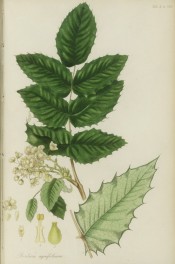Mahonia aquifolium (Pursh) Nutt.
Fully hardy suckering shrub with bright green, holly-like pinnate leaves, each with up to 9 ovate, spiny leaflets, sometimes turning red in autumn, and dense, terminal racemes of yellow flowers in spring followed by blue-black berries. To 1m. [RHSE, Hilliers’, Hortus].
Horticultural & Botanical History
Introduced to Britain in 1823. [JD]. Pursh pl.4/1814.
History at Camden Park
Recorded in a hand written entry in an 1850 catalogue held at the Mitchell Library, inscribed on the front Wm. Macarthur, 23rd Dec. 1854. [ML 635.9m]. It had previously been marked with a ‘c’, denoting grown at Camden, in an 1836 Loddiges’ catalogue held in the Camden Park archives. This suggests that it was actually grown in the gardens well before 1854. [CPA].
Notes
Published Feb 26, 2009 - 05:14 PM | Last updated Jul 14, 2010 - 05:12 PM
| Family | Berberidaceae |
|---|---|
| Category | |
| Region of origin | North America |
| Synonyms |
|
| Common Name | Oregon grape, Mountain holly |
| Name in the Camden Park Record | Berberis aquifolia |
| Confidence level | high |
